TAXI OF TOMORROW: VALUE OF NEW YORK CITY

CREATING THE ICONIC TAXI
Introduction: Taxi Identity
Look out the window of a Manhattan skyscraper any time of day or night, and you are likely to see a stream of yellow, restlessly parting and converging again. This ebb and flow has become a kind of visual geographic shorthand for New York City immediately establishing location in innumerable films, television shows, and commercials. Taxi identity does have something to do with that distinct shade of yellow, but the effectiveness of the taxi as an icon goes beyond its color.
At its most sublime, the taxi symbolizes the power and freedom of New York City. Step off the curb, stick an arm in the air and it can take you where you want to go at any time of day or night. Without question, hailing a cab – with its promise of freedom, power, and anonymity – is the quintessential New York City act. This notion is so deeply rooted that visitors count hailing a cab among top tourist attractions. It’s like visiting the Empire State Building or Rockefeller Center. But like so many legends encountered in person the reality is disappointing.
Stepping into a New York City cab today can bring to mind the vehicular equivalent of Frankenstein’s monster. With their many makeshift adaptations wrought over decades, current cabs whisk passengers through New York City’s dynamic streets under circumstances that feel provisional and look like a mess. Although taxis currently provide an essential New York City experience, New Yorkers agree that they should be more ergonomic (for passengers and drivers), more environmentally sustainable, more accessible, even more elegant – in short, more expressive of the values New Yorkers care about right now.
The Taxi Opportunity
Just as Fifth Avenue or Grand Central Terminal has a distinct public identity enjoyed by anyone who has ever strolled past the Plaza Hotel or stood under the starry ceiling of Grand Central’s main hall, so too does the taxi. Taxis dominate New York City’s visual landscape, provide a crucial transport link, and constitute the space of entry for millions of tourists every year. Every day, New York’s 13,100+ cabs make an average of 470,000 taxi trips carrying 660,000 passengers.
Despite the singular prominence of the New York City taxi – and the profound identification of the yellow cab with the city – no vehicle manufacturer has seized this opportunity to build a brand identity. Since the demise of the beloved Checker in the early 1980s, there has been no meaningful effort to develop an iconic taxi. In fact, vehicle manufacturers have actively rejected associating vehicles with the taxi in part because of fear that the association would diminish brand appeal in other more upmarket contexts.
This outdated conception of the New York City taxi image is incorrect, and underlies a curious failure to capitalize on the strong and overwhelmingly positive image of New York City today. For a host of reasons – not least because New York City has mandated that all taxi vehicles achieve 30 mpg or better by 2012 – the entire New York City taxi fleet is about to undergo a revolution.
The image of the new iconic taxi will be inextricable from the brand of New York City which creates a historic opportunity to fill this vacuum and establish one of the strongest brands on the planet. The right vehicle will automatically control the market, and perhaps, more importantly, its image and features will be internationally recognized with almost no marketing effort. The quantity of televised images that originate on the streets of the city, the volume of visitors who will experience the new vehicle (including political and business leaders from every corner of the globe), and the yellow cab’s prominence as the icon of New York, guarantee that the moment the new vehicle hits the city streets it will be an international sensation.
New York City Today
There can be little argument that New York City stands as a beacon of commerce, art, and culture the world over. Social harmony and economic prosperity prevail in a context of enormous ethnic and racial diversity; there are more languages spoken in the borough of Queens than anywhere on Earth. Although New York City maintains distinctive local neighborhoods it is also an international city whose identity and well being is perhaps more closely tied to international centers like London, Dubai or Hong Kong than to other American cities. In every realm – financial, artistic, ideological or otherwise – trends surface in New York City first.
The City has never felt more robust. Hotels are overbooked, theaters are sold out, and any given evening offers hundreds of activities – from sports to opera, avant garde theater to literary lectures, endless gallery openings to the finest dining anywhere. Even the real estate market seems immune to downturn. Yet thirty years ago, New York seemed unsafe and ungovernable, and was in fact on the brink of bankruptcy. Although the city has changed profoundly since that time its taxis have not.
Replacing the beloved Checker, the Ford Crown Victoria today makes up about 85% of all taxi vehicles. In its heyday, the Crown Vic eloquently expressed the character of the 1970s and ‘80s. Through a period of spiraling crime rates and economic and social upheaval, the Crown Vic earned a grudging respect for its durability and endurance. Even its alternate life as a police vehicle – with a back seat designed for people wearing handcuffs – somehow seemed appropriate at the time. Its rolling implication – it takes a tough car to make it in a tough town – suited the zeitgeist.
New York City has emphatically changed. Today the City’s character is defined by forward looking and pragmatic optimism. An important example of municipal confidence can be found in the Bloomberg Administration’s recently released book long plan for New York City’s future, PlaNYC, which begins:
Thirty years ago, a plan for New York’s future would have seemed futile. ... Today, the city is stronger than ever. Transit ridership is at a fifty year high. Crime is at a forty year low. We have our best bond rating ever, and the lowest unemployment. A record 46 million tourists came to visit last year. For the first time since World War II the average New Yorker is living longer than the average American. And our population is higher than it has ever been.
Moving to New York has always been an act of optimism. ... This Plan is offered in that spirit. – PlaNYC: A Greener, Greater New York, City of New York, April 2007 Received with global acclaim, this thirty year plan for the city’s environmental health lays out ambitious goals for increasing housing and open space, improving water and air quality, reducing traffic, and increasing energy efficiency among others. As PlaNYC illustrates, environmental sustainability is a defining value for 21st Century New York, and will be closely associated with any new taxi vehicle.
DESIGN TRUST’S TAXI 07 + SMART DESIGN
NYC taxi revisited
In 2007, the New York City non-profit Design Trust for Public Space led a consortium of automakers and designers to create taxi prototypes for the Design Trust’s Taxi 07 Exhibit at the 2007 New York International Auto Show. To participate, contributors were required to address Taxi 07’s design challenges, which included a range of short- and long-term improvements for the safety and comfort of passenger and driver, overall vehicle accessibility, space efficiency, and sustainability.
The Design Trust enlisted taxi vehicle aftermarket manufacturers and facilitated their collaboration with top designers to produce prototypes. Smart Design, a key Taxi 07 participant, led one of these teams. Smart’s concepts, developed over several months, were illustrated in the form of two full-size vehicle prototypes, both featured in the Taxi 07 Exhibit. This book captures the thinking that went behind each design element of the Smart vehicles, from the insights that sparked the idea, to suggested formats for implementation.

SMART’S VISION FOR THE NYC TAXI
A user-centered approach
The Design Trust’s Taxi 07 Exhibit aimed to demonstrate – unequivocally and by example – that the yellow cab can powerfully communicate New York City’s commitment to sustainable mobility, access for all, and great design. Smart embraced these goals and approached designing the next generation of taxis like any other design project – by talking to people that use the system and discussing the best and worst aspects of the experience.
Luckily, Smart’s NYC headquarters houses nearly 80 regular taxi users, ranging from born and raised New Yorkers, to international residents. Stories were shared, learning from similar transit systems in such places as Hong Kong, Stockholm, Bangkok and London.
In the end, Smart’s vision for the NYC taxi was based on three tenets: make the taxi experience safer, more social, and more sustainable for all.

DESIGN PARTNERSHIPS
A collaborative effort
The Design Trust’s engagement of interested automakers, component and after-market manufacturers, and top industrial designers, enabled Smart to collaborate with a number of key partners and experts, and to deliver a well informed vision for the future of the NYC taxi.
Smart partnered with a major auto manufacturer, as well as other industry sponsors, to produce prototype parts and to actively support and inform the design process.
New York City design firm Birsel + Seck made important contributions to the cab’s interior design. Antenna Design, also a New York City based design firm, designed the rooftop communication system.
Design Trust for Public Space
Accessible Vans & Mobility
Antenna Design
Birsel + Seck
Bruno Independent Living Aids
Kia Motors
Pulsar Technology Systems Inc.
Taxicab Partitions Inc.
Ultrafabrics LLC
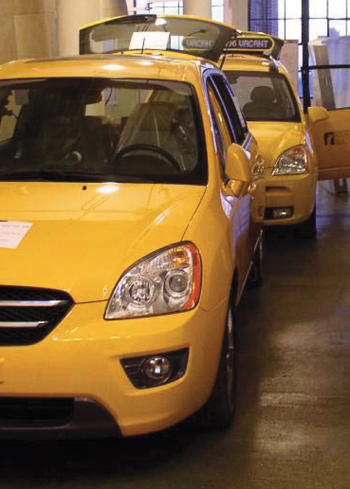
PROTOTYPING PLATFORMS
From sketch to show car
Some of the best design insights come from hands-on learning, prototypes, and physical experimentation. To this end, Smart Design received a donated vehicle to sketch, hack, and otherwise dissect in order to uncover the ideal taxi experience.
As the Taxi 07 exhibit approached, Smart transferred key concepts to a second vehicle, a “production show car” which would present the most near-term solutions at the Auto Show.
However, as more people became interested in the story behind the concepts, the original “sketch” vehicle was also included in the exhibit, revealing the hands-on design process, as well as some of the more ambitious concepts from the Taxi 07 team.

Seating
Insight
While most taxi rides are brief, the seat remains the largest “touch point” of the taxi cab experience for the passenger.
Proper seat design can mean increased rider satisfaction (tips) and a longer lifespan for the seat itself.
Recommendation
The passenger seats are subject to frequent ingress and egress, and should be calibrated for such.
The back seat of the vehicle also has specific suspension requirements, and the seat should be calibrated for the smoothest ride possible.
Seating contours and stitching should be designed for comfort, but should facilitate easy cleaning and minimize the likelihood of losing items in the seat.

Comfort & performance. Seats should be balanced for a smooth ride.

Contours & crevices. Stitching should facilitate cleaning and prevent losing articles in the seat.
Interior lighting
Insight
Dark taxi interiors are often hard to navigate at night. Current interiors are black on black, leaving even seasoned New Yorkers to fumble for door handles and other controls.
Recommendation
Enhanced passenger lighting should be utilized at all passenger touch-points including door handles, foot wells, transaction components, and all relevant window and climate controls.
Overhead spot lighting should illuminate the seating area during ingress/egress, and should also have controls accessible to the passenger for added nighttime convenience.
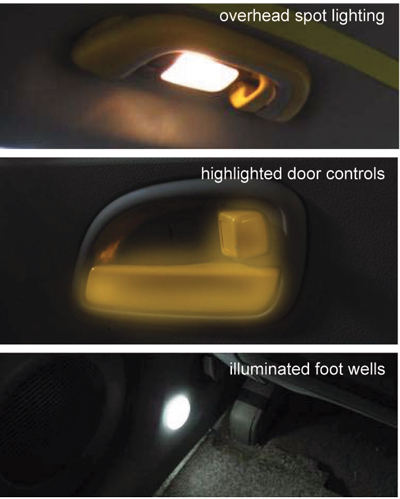
Light the way. Additional lighting aids in navigation and reduces article loss in taxis.
Provisions for work activity
Insight
While most taxi rides are brief, there exists an opportunity to increase passenger productivity (and satisfaction) during longer rides, especially to and from the local airports.
Recommendation
Future generations of the Passenger Information Monitor (PIM) may include more feature-rich applications, with email/web access, real-time flight updates, and hotel and restaurant reservations.
Additionally, the cab interior may offer a standard AC electrical outlet for a quick cell or laptop charge.
Passengers should be able to control the lighting in their space for nighttime visibility.

News and more. Feature-rich content and realtime services on the PIM.
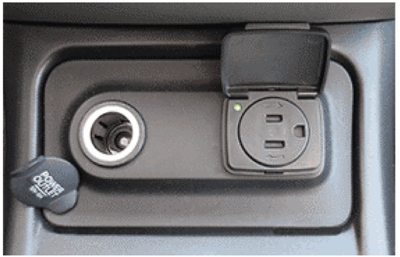
Power to go. An AC outlet could “save the day”
Sight-seeing and visibility
Insight
The taxi represents a tremendous opportunity to showcase the beauty of the city, for residents and visitors alike.
Enhancing the passengers’ enjoyment of the city during a taxi ride further solidifies the taxi as the iconic mode of transportation for New York City. recommendation
Recommendation
The GPS element of the PIM allows for routespecific tourist information (“to your left you will see…”) as well as presenting points of interest and scenic route suggestions.
Furthermore, the best views of New York are not out a side window, but straight up! A panoramic skylight would make a taxi ride the best way to enjoy a skyward view of the city skyline.

Virtual tour guide. Real-time tourist info as you drive by, courtesy of the GPS-enabled PIM.
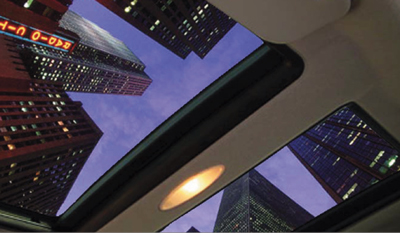
Ride with a view. The best way to view the vertical skyline!
Interior climate control
Insight
Current climate controls for the passenger section are subpar aftermarket retrofits, required as a result of the wall partition.
Additionally, the controls are dark and difficult to reach, leaving most riders to suffer silently.
Recommendation
Climate controls in the passenger section should be as accessible and intuitive as those in the driver’s section, including proper illumination and ergonomic placement of controls.

Clear climate control. Rear climate controls separate driver and passenger preferences.
Provisions for luggage
Insight
Placing all luggage in the trunk of the vehicle is an extra and inconvenient step in the taxi process. Drivers must stop their vehicle longer in the street, frustrating surrounding drivers, and requiring either the driver or passenger to lift the luggage high over the lip of the trunk.
Recommendation
For small and medium luggage, it is faster and easier for riders to bring their bags into the passenger compartment with them. A flexible ratio of trunk and passenger space (as in many crossover SUVs) would provide for this option.
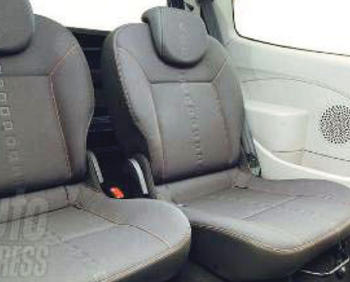
Slide + store. Sliding seats open up space options in the Renault Twingo.
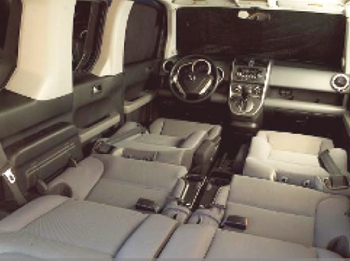
Fold + fit. Folding seat combinations are popular in small SUVs, like the Element.
Partition safety considerations
Insight
Current wall partition configuration provides for driver safety, but creates a large obstacle during collisions, resulting in passenger injury.
Recommendation
An L-shaped partition maintains driver safety while reducing the obstacle for passengers. A combination of safety considerations in the design of a new partition, as well as encouraging safety belt compliance, would greatly reduce the likelihood for passenger injury.
In designing an L-shaped partition, particular attention should be given to rounding (or padding) corners, as well as utilizing scratch resistant materials, to provide optimal driver visibility.

Minimize obstacle, maximize safety. An L shaped partition offers safety with fewer risks.
Universal taxi design
Insight
The current low-slung fleet of sedans provides little consideration for passengers of limited mobility, with walkers, additional baggage, larger framed passengers, or parents traveling with child strollers.
Recommendation
In considering a new vehicle platform, a “universal design” approach should be adopted. Details such as door frame width and height, door opening angle, seat height, lighting and visibility should all be targeted to provide for the widest range of people possible.
This approach will facilitate not only disabled riders, but enhance and ease the experience of “abled” riders as well.

Wide doors for those with bags or kids.
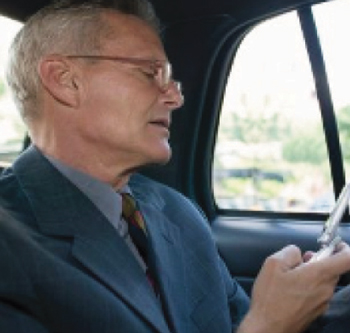
Clear graphics for the elderly or vision impaired.

Seating and suspension for large frame or pregnant riders.
Taxi for all. Solving for the most challenging passengers yields a better experience for all.
Passengers with reduced mobility
Insight
The current taxi system offers disproportionately few provisions for less mobile passengers, including the elderly, disabled, and wheelchairbound.
Recommendation
Ideally, full wheelchair accessibility would achieve the goal of a “universal” taxi, but in the interim, alternate offerings could provide a balanced and economic solution to a wider range of less-abled passengers.
An outward-turning front passenger chair with a lowered seat height would provide a valuable accessibility solution without sacrificing the efficiency of a smaller vehicle platform.
Generally, targeting a more “universal” vehicle platform height will make the taxi more accessible.

Efficient accessibility. A motorized turn-out seat increases accessibility
while maintaining a smaller, more efficient vehicle platform.
DRIVER COMFORT + SAFETY
Driver’s seat
Insight
Taxi drivers often work in 12-hour shifts on an uncomfortable Crown Victoria bench seat. As a result of these grueling work conditions, many drivers complain of hemorrhoids and lower back pain.
Recommendation
These demanding conditions require a specialized driver seat, with ergonomic considerations similar to that of an interstate truck driver.
The driver seat design should promote proper blood flow, reduce joint pain, alleviate pressure points, and be “breathable” to distribute temperature comfortably.

Long haul. 12 hour shifts require seat performance similar to that of an interstate trucker.

© 2015 TLC Magazine Online, Inc. |